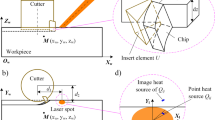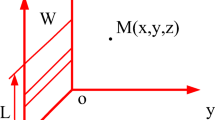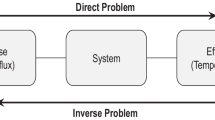Abstract
A thermal model that reveals workpiece temperature variation in bull-nose end milling is presented in this paper. Both machining history and cutting tool are discretized into elements to tackle the problems of interrupted cutting process and complex cutter geometry. In the proposed modeling methodology, shear plane heat source is considered as moving instantaneous rectangular heat source. Image heat source is applied to deal with boundary issues of heat conduction in workpiece. The proposed model is validated by machining 300 M steel under dry cutting state. Good agreement between the estimated and measured workpiece temperatures indicates that the analytical model can provide accurate predicted results. The effects of spindle speed and feed rate on workpiece temperature are theoretically and experimentally investigated. Some conclusions of this study are summarized as follows: (1) In the studied range of processing parameters, workpiece temperature increases with increasing spindle speed and decreases with increasing feed rate. (2) Temperature in workpiece under stable milling state decreases exponentially with increasing horizontal distance between inner point and machined surface.
Similar content being viewed by others
References
Jaeger JC (1942) Moving sources of heat and the temperature of sliding contacts. J Proc Roy Soc NSW 76:202
Hahn RS (1951) On the temperature developed at the shear plane in the metal cutting process. Proceedings of First U.S. National Congress of Applied Mechanics;661–666
Komanduri R, Hou ZB (2001) Thermal modeling of the metal cutting process—Part III: temperature rise distribution due to the combined effects of shear plane heat source and the tool–chip interface frictional heat source. Int J Mech Sci 43(1):89–107
Karpat Y, Özel T (2008) Analytical and thermal modeling of high-speed machining with chamfered tools. J Manuf Sci Eng 130(1):011001
Haddag B, Nouari M (2013) Tool wear and heat transfer analyses in dry machining based on multi-steps numerical modelling and experimental validation. Wear 302(1):1158–1170
Li L, Li B, Ehmann KF, Li X (2013) A thermo-mechanical model of dry orthogonal cutting and its experimental validation through embedded micro-scale thin film thermocouple arrays in PCBN tooling. Int J Mach Tools Manuf 70:70–87
Agarwal S, Rao PV (2013) Predictive modeling of force and power based on a new analytical undeformed chip thickness model in ceramic grinding. Int J Mach Tools Manuf 65:68–78
Lefebvre A, Lanzetta F, Lipinski P, Torrance AA (2012) Measurement of grinding temperatures using a foil/workpiece thermocouple. Int J Mach Tools Manuf 58:1–10
Hadad M, Sadeghi B (2012) Thermal analysis of minimum quantity lubrication-MQL grinding process. Int J Mach Tools Manuf 63:1–15
Hadad MJ, Tawakoli T, Sadeghi MH, Sadeghi B (2012) Temperature and energy partition in minimum quantity lubrication-MQL grinding process. Int J Mach Tools Manuf 54:10–17
Mamalis AG, Manolakos DE, Markopoulos A, Kunádrk J, Gyáni K (2003) Thermal modelling of surface grinding using implicit finite element techniques. Int J Adv Manuf Technol 21(12):929–934
Mohamed ALMO, Warkentin A, Bauer R (2012) Variable heat flux in numerical simulation of grinding temperatures. Int J Adv Manuf Technol 63(5–8):549–554
Barrios ANS, Silva JBC, Rodrigues AR, Coelho RT, Junior AB, Matsumoto H (2014) Modeling heat transfer in die milling. Appl Therm Eng 64(1):108–116
Jiang F, Liu Z, Wan Y, Shi Z (2013) Analytical modeling and experimental investigation of tool and workpiece temperatures for interrupted cutting 1045 steel by inverse heat conduction method. J Mater Process Technol 213(6):887–894
Chen G, Ren C, Zhang P, Cui K, Li Y (2013) Measurement and finite element simulation of micro-cutting temperatures of tool tip and workpiece. Int J Mach Tools Manuf 75:16–26
Kuo HY, Meyer K, Lindle R, Ni J (2012) Estimation of milling tool temperature considering coolant and wear. J Manuf Sci Eng 134(3):031002
Sato M, Tamura N, Tanaka H (2011) Temperature variation in the cutting tool in end milling. J Manuf Sci Eng 133(2):021005
Le Coz G, Dudzinski D (2014) Temperature variation in the workpiece and in the cutting tool when dry milling Inconel 718. Int J Adv Manuf Technol 74(5–8):1133–1139
Lin S, Peng F, Wen J, Liu Y, Yan R (2013) An investigation of workpiece temperature variation in end milling considering flank rubbing effect. Int J Mach Tools Manuf 73:71–86
Hou Z, He S, Li S (1984) Conduction of heat in solids. Shanghai Scientific and Technical Publishers, Shanghai
Engin S, Altintas Y (2001) Mechanics and dynamics of general milling cutters. Part I: helical end mills. Int J Mach Tools Manuf 41(15):2195–2212
Armarego EJA, Whitfield RC (1985) Computer based modelling of popular machining operations for force and power prediction. CIRP Ann Manuf Technol 34(1):65–69
Moufki A, Dudzinski D, Molinari A, Rausch M (2000) Thermoviscoplastic modelling of oblique cutting: forces and chip flow predictions. Int J Mech Sci 42(6):1205–1232
Merchant ME (1944) Basic mechanics of the metal cutting process. J Appl Mech 11(A):168–175
Shaw MC (2005) Metal cutting principles. Oxford University Press, New York
Komanduri R, Hou ZB (2000) Thermal modeling of the metal cutting process: Part I—temperature rise distribution due to shear plane heat source. Int J Mech Sci 42(9):1715–1752
Yan L, Yang W, Jin H, Wang Z (2012) Analytical modelling of microstructure changes in the machining of 304 stainless steel. Int J Adv Manuf Technol 58(1–4):45–55
Wan M, Zhang WH, Tan G, Qin G (2007) New cutting force modeling approach for flat end mill. Chin J Aeronaut 20(3):282–288
Author information
Authors and Affiliations
Corresponding author
Rights and permissions
About this article
Cite this article
Yan, R., Zeng, H.H., Peng, F.Y. et al. Analytical modeling and experimental validation of workpiece temperature variation in bull-nose end milling. Int J Adv Manuf Technol 86, 155–168 (2016). https://doi.org/10.1007/s00170-015-8130-y
Received:
Accepted:
Published:
Issue Date:
DOI: https://doi.org/10.1007/s00170-015-8130-y




